1.
Pursat Town
Dusty, dirty boomtown Pursat is another brandnew, respectively newly rebuilt city in Cambodia. It lies some 20km southwest of the Tonle Sap Lake, along NH5 between Phnom Penh and Battambang.

A slum seam at the eastern outskirts of Pursat. Image by Asienreisender, 1/2016
Pursat town is the capital of Pursat Province. The town is situated in the flat plains who are so typical for Cambodia, along the Pursat River who crosses the province and drains into the Tonle Sap Lake some 20km northeast. The town is small and estimated at roughly 26,000 people. Nevertheless it's very busy nowadays, since anyone over eight years seems to drive at least a motorbike, if not a car.
However, the province is quite large and stretches as far west that it borders Thailand in the Cardamom Mountains. The old, at the time out of use French railway line runs through town and via a desolate bridge over the Pursat River. Since years is the reactivation of the line announced, but sometimes things go slowly here. There is over a few kilometers a simple 'wooden train' running, maintained by some locals, and driven by a lawnmower engine. It's the same kind as the weired tourist attraction of the 'bamboo train' in Battambang. The name 'Pursat' is allegedly translatable to 'drifting bodhi tree' and comes with an according legend.
A Wooden Train
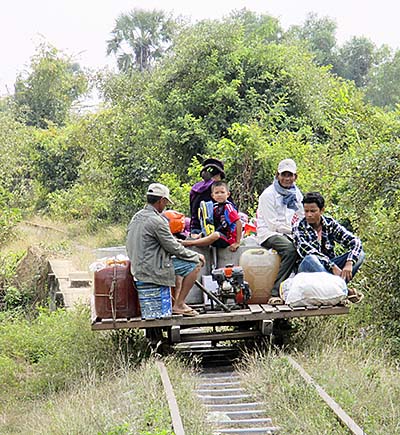
This simple wooden frame, driven by a lawnmower engine, is a very similar vehicle to the among Cambodia travellers quite famous 'bamboo train' in Battambang Province. The locals use it as a mean of transport for their goods and themselves. Image by Asienreisender, 1/2016
A peculiarity of the town is an artificial island shaped as a ship. It's called Koh Sampovmeas. According to a legend once a ship sank or stuck here and couldn't be removed. Over the time an island grew out at the spot. The artificial shape it has now was built under order of one of the Cambodian oligarchs, the minister of industry, mining and power.
Anywhere in the province's mountains is at least one marble grannary. It's the only place in the country where marble exists, and the source is exploited to deliver the stone to a number of local workshops who produce useless items of it, mostly Buddha statues or other religious items or other pieces like animals. Certainly the marble is also used in a greater amount in the construction sector to feed the status symbol hungry who can afford it.
About six kilometers out of town is a site which is valued as a 'must see' in the official tourist brochure of Pursat. It's Oknha Klang Meung. The story of it is denoting of the distorted value system the locals get taught by their authorities.
A Fruit Shop

Inside a shop on Pursat's fresh market. The shops always stretch out and occupy the whole sidewalk. The little girl, the owner's daughter, refused to look into the camera. It's her very right not to do so, if she does not like to. Image by Asienreisender, 1/2016
It's about Klang Meung who killed his family and committed suicide in order to mobilize spirits to help the ruling king (what king is not specified) in regaining his power (who he apparently lost in whatever event before). Thanks to the supporting spirits the king's army succeeded in whatever (also not specified, but certainly bloody, when the army was involved). Klang Meung is therefore seen as a local hero.
As ridiculous the story sounds, a serious matter of fact is that a certain part of the dull locals take it as given, and make the cave, where a statue dedicated to the 'hero' is placed, a pilgrimage site. Apart from the superstitious belief in spirits, the locals should have been grateful to get rid from their despotic rulers - in past and present.
In another version (nothing is clear in this country, nothing...) Okna Meung is stylized as a hero who defeated a Siamese army in 1482 CE. Never heared of that battle, by the way. Could be wishful thinking.
Pursat's French Railway Station
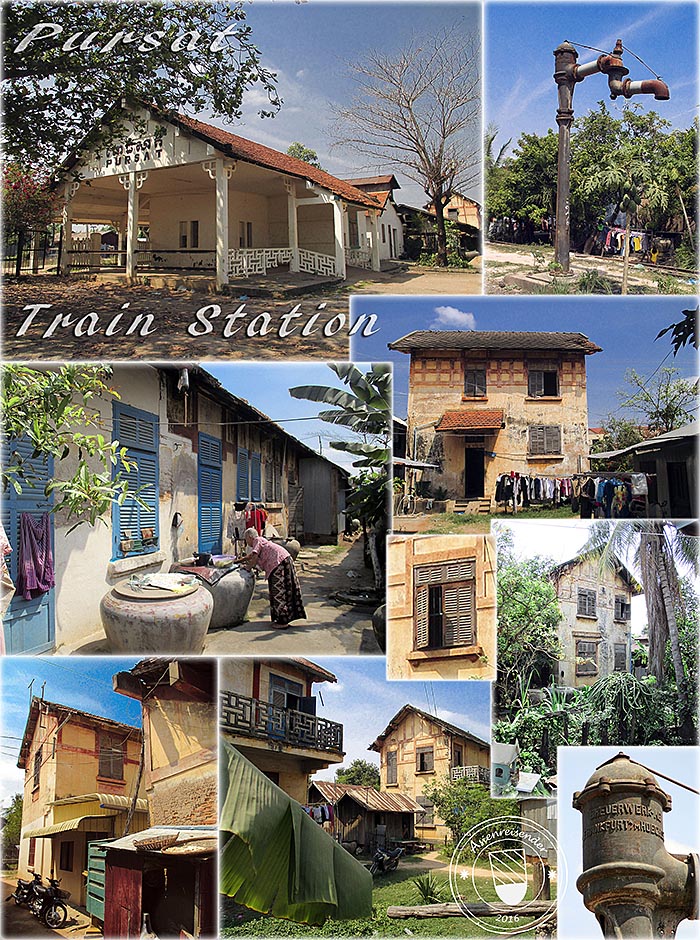
Situated along the old railway line between Poipet and Phnom Penh, Pursat has an old railway station. Here, a few hundred meters north of the river and the contemporary town center, has probably been the center of the place in colonial times. Left of it are, apart from the station building, the railway, a platform and an iron pump to fill water into the steam engines of the locomotives of the time, a few old houses, built in French countryside style. I wouldn't wonder if they still represent the best building quality in today's Pursat, because all what is built here new, as well the facades may look, is of low quality and malfunctional. It's brandnew rubbish. Images and photocomposition by Asienreisender, 2/2016
2.
The Cardamom Mountains
Pursat Province stretches deeply into the Cardamom Mountains. This large mountain massive is the last area in Cambodia where nature has some last refuges, although human encroachment happens from all sides and mountain villages expand. The Cardamoms are home of a large number of seldom, endangered animals.
Wood Carvings

This is merely a small collcetion of wood carvings, seen in Pursat Century Hotel. There is much more. Shops and woodworkers in town are plenty. I also see frequently vehicles with loads of wood around. Image by Asienreisender, 2/2016
When driving westwards from Pursat town riverupwards, soon the first mountain ridges appear southwest. The both parallel roads to the river change into dirt roads and go ever narrower, until, after a few kilometers, they are merely paths. A few cowherds guard their cattle here. Now, in January, the landscapes are bone dry and dusty. The yet absense of asphalt roads prevents the mountains from more exploitation, although, doubtlessly, a great deal of harm is already done and furthermore ongoing. New roads will follow soon.
A few kilometers south runs the yet only asphalt road, no. 155, towards Veal Veng. It is paralleling a mountain ridge which stretches south of it. At the slopes of these mountains are larger teak plantations established.
The plains in the vicinity of Pursat River are acreage. New irrigation canals spread out and with it farming and housing. It's said that the soil is generally very fertile in the province, particularly towards Battambang in the north, which is well-known for it's fertility and agricultural productivity. Here, towards the mountains, the soil is pretty sandy and I doubt it's that fertile.
In the not so far ago past the most of the whole, large area was covered with boondocks. Now there is nothing of the virgin forest left in the plains; only the steeper mountain slopes are still forested.
In Pursat town are several woodworkshops who produce large and sophisticated woodcarvings with no practical value, being only expensive souvenirs. Others produce massive furniture with the woods from the Cardamom Mountains. It's certainly not necessary to mention that the forests exploitation is ongoing and unsustainable, and nobody cares for that fact.
An Outer Chain of the Cardamom Mountains

The westernmost arms of the Cardamom Mountain Massive consist of a few, isolated hill chains surrounded by plains. To the west and partially the south the mountains are higher. Phnom Auroal is Cambodia's highest peak (1,813m). Eastwards now the slopes lower into the large Cambodian plain and down to the great lake. The soil is sandy here, and the slopes are all cleared from the semi arid forests and changed into arable land. A great part of the acreage is used for the production of cash crops. Cassava and teak plantations are predominant. Image by Asienreisender, 1/2016
3.
Tonle Sap Lake
Local Dwelling

A local house at what I would see as the edge of the flooding area of the grand lake. However, there is no clear shore and the water can rise higher occasionally. Image by Asienreisender, 1/2016
Pursat stretches not only west into the mountains but also, to the other side, into Southeast Asia's great lake, the Tonle Sap. Tonle Sap Lake is a complicated ecosystem and part of the Greater Mekong River catchment area. The lake swells considerably in the rainy season, when the lower Mekong River is carrying so much water that it's stream reverses the flow and presses water upwards into the Tonle Sap river, filling the lake. In dry season, on the contrary, the water retreats and uncovers great parts of land, which is used then by local farmers for planting rice, vegetables or driving their cattle there.
The Pursat River drains into the Tonle Sap as many other, smaller rivers do. Cambodia is rich in water and rivers, and the great lake is the central water reservoir of the country. However, one has to mention here that this ecosystem is under severe threat by all the attempts of 'Damming the Mekong' and it's tributaries as well as water withdrawal, particularly in Thailand's northeast (the Isan) for irrigation purposes. Following the Pursat River downstream in dry season gives a good impression of how the landscapes look.
Tonle Sap Lake at Pursat
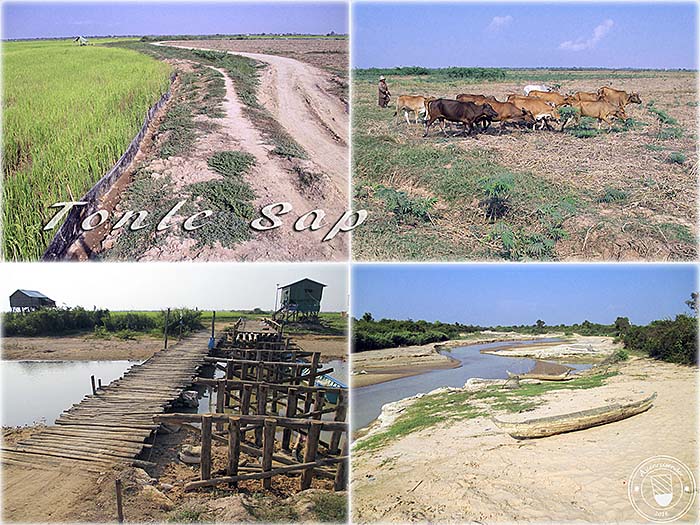
Following the Pursat River downstream one enters the ground of the lake, so far it is dry season. The ground is sandy, it's a yellow sand, on the first glance similar to that at seasides. However, there are, at a closer look, very different kinds of sand. At some spots rice is cultivated, here and there is cattle around. Some sandy dirt roads crisscross the landscape. In rainy season, from June on, it's all flooded again. Images and photocomposition by Asienreisender, 1/2016
The Floating Village of Kampung Luong
Roughly 28km east of Pursat lies Krakor, a spot on the NH5. From there it's another 3km or so to the shores of the Tonle Sap Lake, along a dirt road. There is a bridgehead of a hamlet. Offshore lies Kampong Luong, one of the floating villages on the lake.
The bridgehead is an ugly slum which consists of a number of rough shacks along the last few meters of the dirt road. The shacks are built of rubbish and the whole place is so filthy that it literally drowns in garbage. Since the Cambodians have the ugly habit to drop their litter wherever they go, stand, sit, lie or drive, all the crap pils up here; moreover all the litter in the lake gets flushed ashore and accumulates here. The filth who comes together with the mannerless kind of the Khmer gives one a great view on what poverty is. One is now at the very bottom of the social pyramid. The trouble is, that it is not any better on the top of the social pyramid - the difference is merely that there everything is expensive and lavish. None of them has any culture.
Kampung Luong
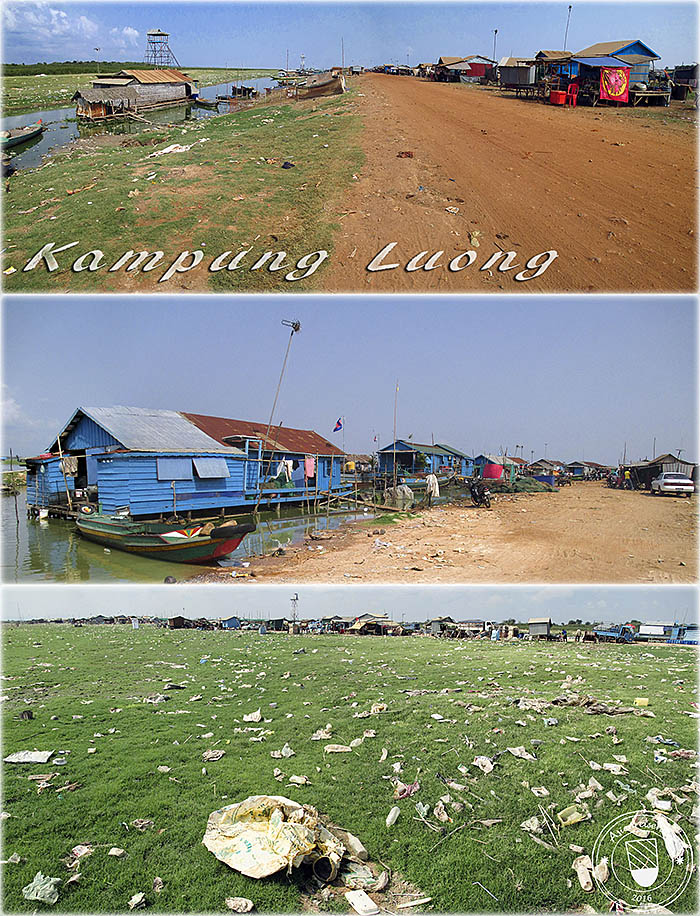
The bridgehead of Kampung Luong exists only seasonal. In the rainy season it's all flooded. The washed ashore litter is an indicator for how high the flood does rise, and it stretches for about one to two kilometers west towards Krator, the small town at NH5.
Remarkable is that the sand here is of a reddish colour, in difference to the yellow sand 30km northwards at the mouth of Pursat River. Images and photocomposition by Asienreisender, 2/2016
Well, here at the bridgehead the people are clearly Khmer, while the floating village has a population of Khmer and Vietnamese fishermen. There is also a catholic church in the village for the christian part of the Vietnamese. These people live from the lake since decades. The floating village is itself nothing more than a floating slum, inhabited by the poorest. It was here that some years ago three fishermen were killed in an uprise against the government politics of giving fishing concessions to large companies who endanger the economic basics of the local villagers. The ecology of the endangered lake is under severe threat due to overfishing and pollution.
The place receives not much, but some tourism. After all it's at least enough that the place turned into a tourist trap. Boring package tours are sold, who include a visit to the floating village, to a Cambodian school, a crocodile farm and some other places. Funny thing, a visit at one of the crocodile farms costs a dollar extra at feeding time. As though they wouldn't feed the crocodiles when no tourist comes. My own capacity for cruelty to animals was already overstretched after I had to watch the abuse of a young pig on the way to the bridgehead, done by a couple of savage Khmer villagers. The crocodiles here are bread for their skin. Wild crocodiles don't live in the lake anymore; in the past, Tonle Sap was home for the Siamese Crocodile as well as the large, Southeast Asian Saltwater Crocodile, the largest crocodile in the world.
The Floating Village of Kampung Luong
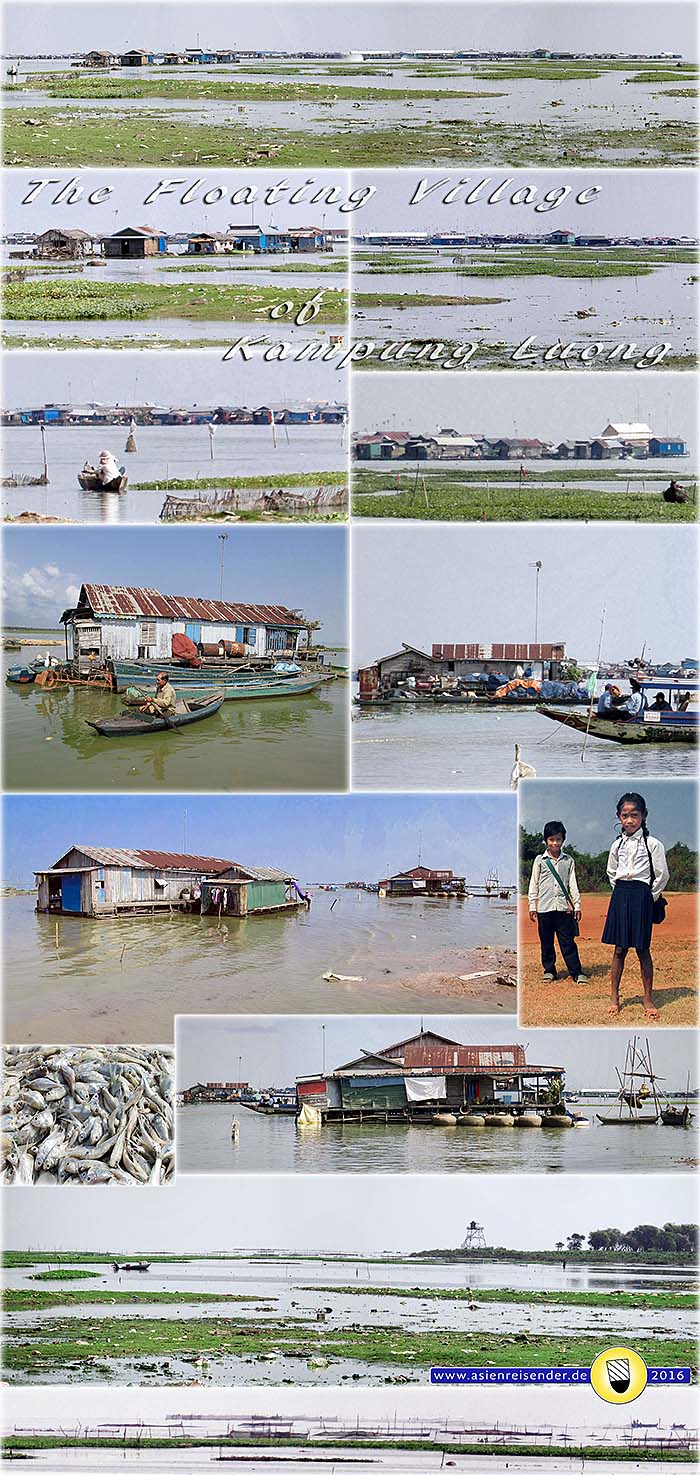
The floating village of Kampung Luong is literally drowning in it's own litter. Pollution is rampant, as everywhere where people go and live. Also the amount of fisheries is impressing. The lakes has recently been declared by experts 'as endangered lake 2016'. That has much to do with the effects of the Mekong Dams and climate change.
However, overfishing is another problem. The crocodile farms consume a lot of fish and snakes as food for the grand lizards. This waste is done for the sake of the production of crocodile leather, which fullfills the luxurious wishes of wealthy ladies in more glamorous places of the world - crocodile leather handbags, wallets, jackets, belts and whatever is considered as a status symbol in our mad, globalized society. The most crocodile farms in Cambodia are supposedly concentrated in the Siem Reap area. Images and photocomposition by Asienreisender, 2/2016